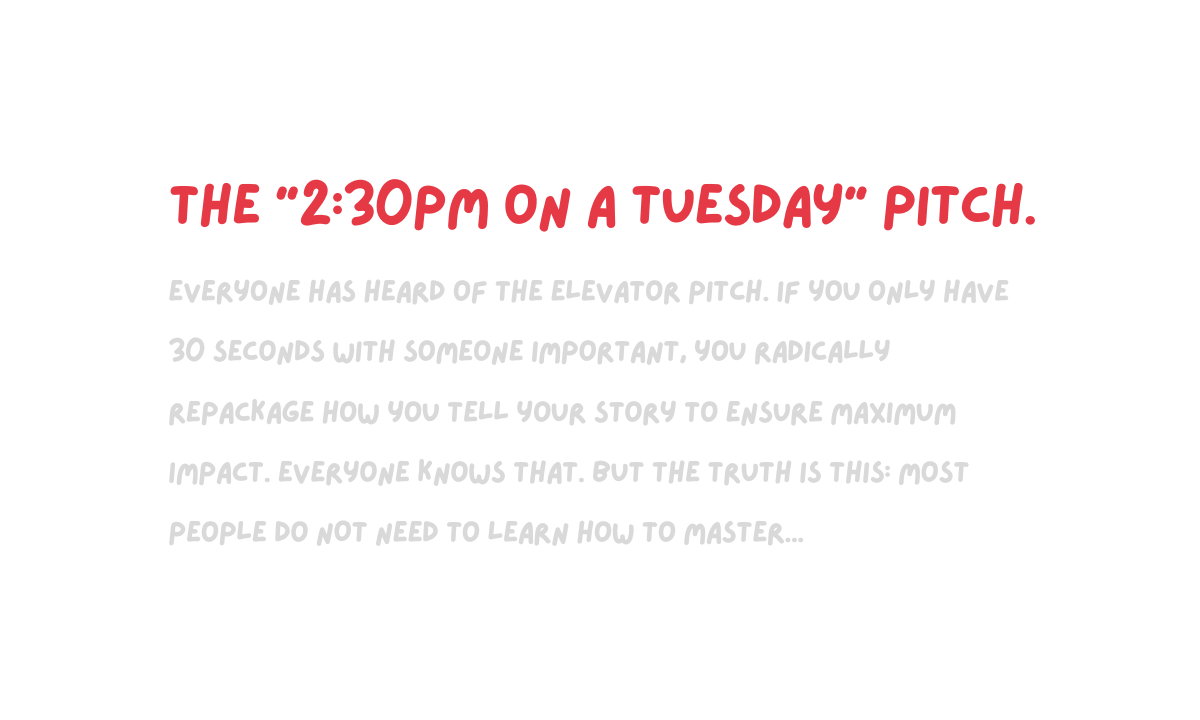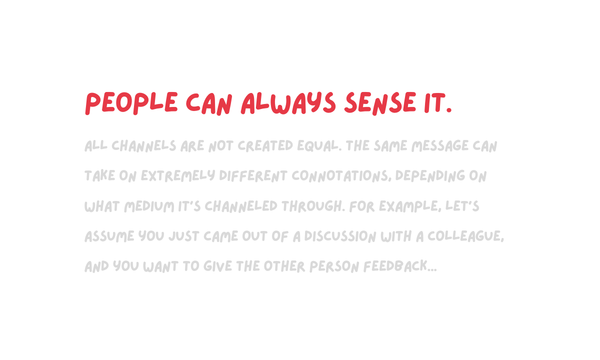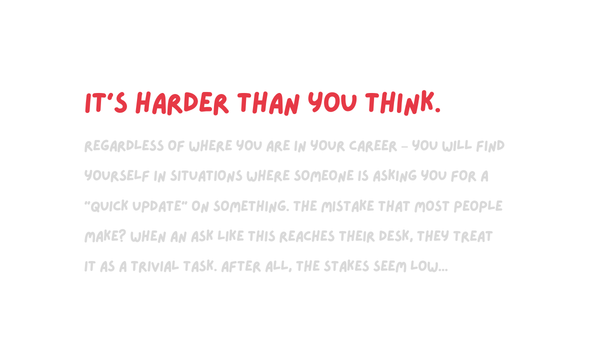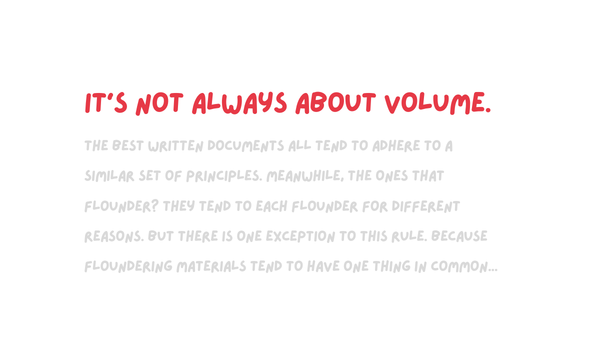You Don't Need an Elevator Pitch (Here's Why).

Everyone has heard of the elevator pitch. If you only have 30 seconds with someone important, you radically repackage how you tell your story to ensure maximum impact.
Everyone knows that.
But the truth is this: most people do NOT need to learn how to master the elevator pitch.
Instead, they need to master what I call the "2:30pm on a Tuesday" pitch.
What does this mean exactly?
What is the significance of 2:30pm on a Tuesday?
The answer is this: nothing.
You could be meeting anyone at 2:30pm on a Tuesday. It could be with:
- People on your team (with shared context)
- A senior leader (who is short on time)
- Cross-functional stakeholders
- A pushy business partner
- A distrustful audience
The point is this: You could be meeting anyone. And how you deliver your message should vary accordingly.
But most people don't do this.
Sure, they'll rehearse their elevator pitch for that one shining moment when they run into the big boss.
Yet at their 2:30pm meeting on Tuesday (with a cross-functional audience), they'll deliver the same spiel they used on Monday (in their team meeting).
They ignore the importance of daily communication hygiene.
👋 Subscribe for free to get Herng's newsletter directly in your inbox.
3 ways to avoid this mistake
Let me be clear – ensuring daily communication hygiene is hard. It requires time and effort. It can also be mentally taxing.
After all, you're always putting yourself in other people's shoes. And you're forced to constantly recalibrate what (and how) you communicate.
(But if you continue to build this muscle and maintain this rigour – I guarantee it'll pay off in the long run.)
To practice this hygiene – here are 3 simple questions I ask myself prior to (and sometimes even during) any meeting or presentation:
1️⃣ "How much context does the audience have?"
Context is everything. The same message can result in drastically different outcomes depending on context.
If your audience has limited context – invest time into context-setting. Sometimes establishing the context is the hardest yet most valuable part.
But what if you're not sure whether the audience has context?
Simple – just ask the audience upfront!
Ask them how much context they have, or how familiar they are with a topic. It is one of the most effective things you can do to ensure communication hygiene.
(Some people shy away from this and simply jump into their spiel. I assume they think that asking questions as the presenter demonstrates weakness. Quite the contrary.)
When you are intentional about context, you'll ask yourself questions like:
Is the audience aware of why we're investing in this project? Or should I explain the rationale behind this bet?
Is the audience familiar with the decision frameworks we use in this space? Or do I have to walk them through the principles first?
Does the audience understand what "good" looks like in our org? How can I help them understand that 1% growth is considered remarkable (and avoid misinterpretation later)?
When you set proper context – you save everybody time in the long run.
2️⃣ "What do they care about?"
A quick story first.
Early on in my Google career, there was a period of time where I was in charge of capturing notes from revenue forecast discussions every week.
As part of that, I was also on the hook to curate those updates and turn them into 2 to 3 crisp bullet points for the big boss.
It seemed like a trivial exercise. So in the absence of guidance, I simply relied on instinct.
Some weeks I simply picked the updates that I actually understood. Some weeks I picked updates that had big numbers. And some weeks I picked updates that contained interesting industry stories.
I did not realize the issue with my approach, until my manager sat me down one day and asked:
What do you think [big boss] actually cares about? What do you think this process is intended to achieve?
It was only at that moment that I realized: I had no idea who I was writing for – and why. I was not curating. I was simply transcribing.
(And doing it poorly and inconsistently.)
Because I was not thinking about my end audience, and what they needed.
As the years went on, I stopped making this mistake. But I also started becoming more aware of it whenever I saw it happening around me.
For instance, I would notice:
- Meetings when people ramble on about tactical processes – not realizing the audience only cares about business outcomes
- Presentations where people only talk about highlights – not realizing the leader wants an honest assessment of challenges
- Discussions where people focus on things that matter in their own world – but are trivial or irrelevant for the big boss in the room
Not thinking about what matters for your audience is detrimental to communication hygiene. You end up wasting everybody's time.
So back to my story. Had I realized the importance of thinking about what my audience needed, I probably would've curated talking points that:
- Moved the needle for leadership (e.g. affected significant revenue)
- Had broader implications for the org (e.g. competitive intel)
- Provided material insight or learnings (e.g. scalable best practices)
3️⃣ "What tone am I taking?"
A message can land very differently depending on the tone we take.
The problem? Some people don't even realize what tone they're using. And they definitely don't think through what tone they need.
Here's an example. Let's say that you're on the hook to present what your team accomplished over the past quarter.
Do you deliver your presentation with a...
- ...Self-promoting tone? ("We had an incredible quarter, as our bets paid off handsomely – let me talk you through how we got there")
- ...Cautiously optimistic tone? ("We exceeded expectations this quarter, although we cannot ignore these 2 risks on the horizon")
- ...Neutral and educational tone? ("We exceeded expectations this quarter due to three initiatives – two of which have wide applicability for other markets")
- ...Grounded yet slightly salesy tone? ("We're proud of our delivery this quarter, but due to a limited budget, we might have left money on the table")
All of the above have a time and place. But you have to actually be aware of the difference. And you have to be intentional about what you're trying to achieve.
Don't be in a situation where you're patting yourself on the back, when the circumstances call for cautious optimism.
(Similarly – don't be in a situation where you're dispassionately spelling out the facts, when you're actually expected to advocate and champion.)
Context matters. Audience matters. Intentionality matters.
So stop focusing on your elevator pitch. And prep for your Tuesday 2:30pm meeting instead.


